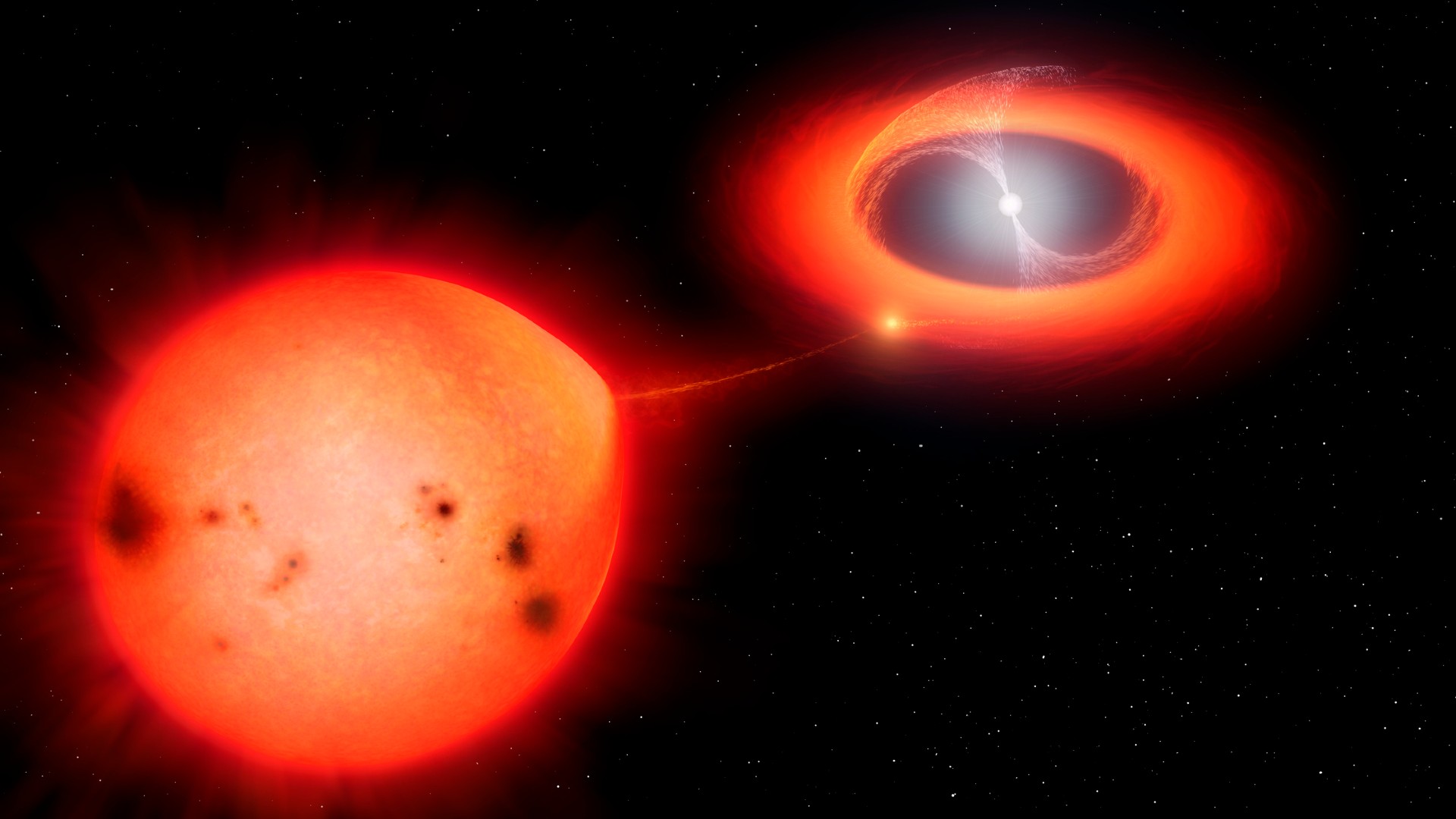'Cannibal' stars have shortest known orbit of all binary systems
A white dwarf has been cannibalizing a former sun-like star, resulting in their orbits around one another shortening to just 51 minutes.

An explosive cannibal white dwarf has been discovered in an incredibly close orbit around its stellar victim, proving a 30-year-old theory about how such binary star systems evolve.
Discovered in images taken by the Zwicky Transient Facility at the Palomar Observatory in California, the system, known as ZTF J1813+4251, is located 3,000 light-years away. It features a white dwarf star and the remains of a once-sun-like star that orbit one another every 51 minutes.
ZTF J1813+4251 is a classic example of a cataclysmic variable. The gravity of the compact white dwarf is strong enough to steal gas from the hydrogen envelope around its close companion star. This gas then forms a bridge between the two, streaming onto the white dwarf's surface. As the density of the accrued material builds up, it ignites in a thermonuclear explosion called a nova. It's not powerful enough to destroy the star, and so periodically these explosions occur and cause the system to brighten, hence the name 'cataclysmic variable.'
Related: Mysterious high-speed gas cloud in space might be the result of an explosive stellar death
Kevin Burdge of the Massachusetts Institute of Technology used an algorithm to search through images of a billion stars taken by the Zwicky Transient Facility, looking for systems suspected of being cataclysmic variables. The ZTF J1813+4251 system stood out because it is also an eclipsing binary — as the two stars orbit one another, we can see one pass in front of and eclipse the other from our point of view, causing the system to 'blink' as its brightness varies with the regularity of the eclipses.
"This thing popped up, where I saw an eclipse happening every 51 minutes, and I said, okay, this is definitely a binary," said Burdge in a statement.
Burdge and his team followed up with the W. M. Keck Observatory in Hawaii and the Gran Telescopio Canarias in the Canary Islands, measuring the mass, radius and precise orbital periods of the stars.
Breaking space news, the latest updates on rocket launches, skywatching events and more!
The orbital period of 51 minutes is the shortest orbital period yet found for a cataclysmic variable, and it has allowed Burdge's team to put together a history of events for the system. As the two stars moved closer, the white dwarf began to whittle away the sun-like companion, which itself would have been aging and evolving into a red giant, its outer layers of hydrogen swelling up and susceptible to being stolen away by the white dwarf's gravity. Over millions of years, so much hydrogen gas was stolen from the red giant that its helium-rich core has been exposed.
The two stars will continue to snuggle up to one another for another 70 million years, their orbital period reducing until the pair orbit around one another in a mere 18 minutes. After that point, once the accretion stops as the available gas has run out, the two will slowly drift apart.
"This is a rare case where we caught one of these systems in the act of switching from hydrogen to helium accretion," said Kevin Burdge of the Massachusetts Institute of Technology in a statement. "People predicted that these objects should transition to ultrashort orbits, and it was debated for a long time whether they could get short enough to emit gravitational waves. This discovery puts that to rest."
So far, gravitational waves have not been detected from ZTF J1813+4251. Their low frequency, long wavelength means that rather than the ground-based LIGO gravitational-wave detector observing them, it may fall to the European Space Agency's LISA (Laser Interferometer Space Antenna) to detect the gravitational waves from ZTF J1813+4251 when it launches in the 2030s.
The research is published in the journal Nature.
Follow Keith Cooper on Twitter @21stCenturySETI. Follow us on Twitter @Spacedotcom and on Facebook.

Keith Cooper is a freelance science journalist and editor in the United Kingdom, and has a degree in physics and astrophysics from the University of Manchester. He's the author of "The Contact Paradox: Challenging Our Assumptions in the Search for Extraterrestrial Intelligence" (Bloomsbury Sigma, 2020) and has written articles on astronomy, space, physics and astrobiology for a multitude of magazines and websites.
